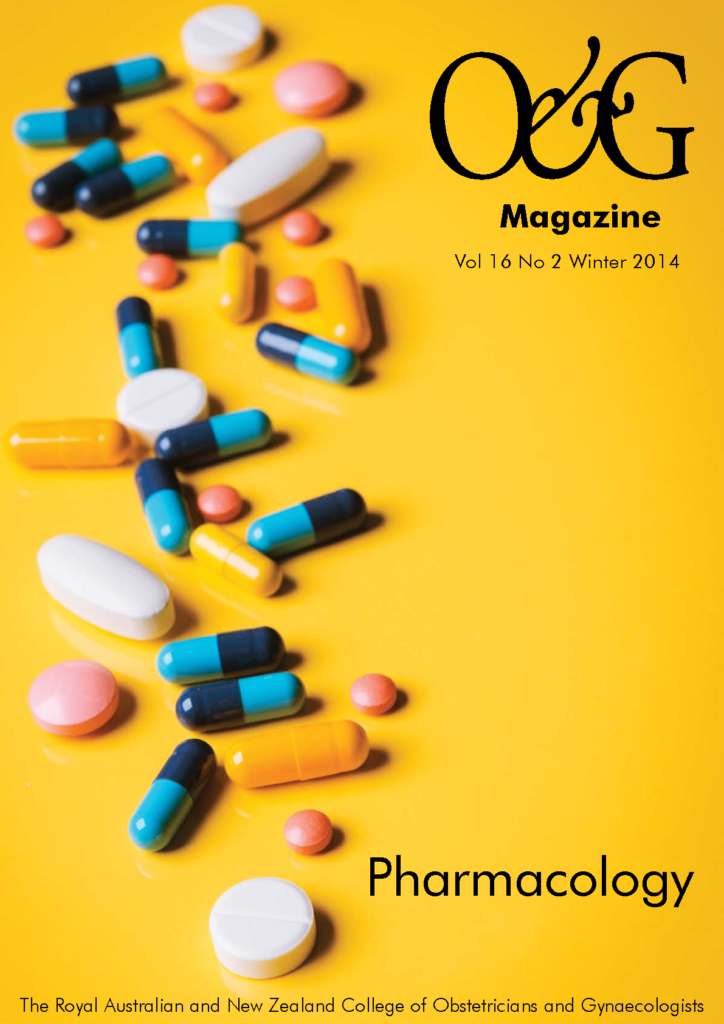Anxiety and depression in association with pregnancy, childbirth and the postnatal period remains poorly diagnosed and undertreated.
There is significant morbidity and mortality associated with mental health disorders in pregnancy and the puerperal period. Antenatal anxiety occurs frequently, overlaps with depression and increases the likelihood of postnatal depression.
Up to 80 per cent of mothers experience the ‘baby blues’ three-to-five days after giving birth. This period of emotional liability is transient and self-limiting, usually dissipating within ten days.
Australian research suggests that around 40 per cent of new parents experience adjustment disorders. Furthermore, up to ten per cent of women experience antenatal anxiety and/or depression, increasing to 16 per cent of women experiencing postnatal anxiety and/or depression with about one-third of fathers also experiencing a depression or anxiety disorder. Puerperal psychosis, which is considered a psychiatric emergency, affects around one in 1000 women. Bipolar disorder is at greater risk of reoccurring postpartum and women with severe psychiatric disorders (bipolar, schizophrenia, major depression) have a 70-fold increased risk of suicide in the first postnatal year.1
Suicide has become one of the leading causes of maternal deaths in Australia.2 The presence of maternal mental health conditions can also have an adverse impact on the growth and development of the fetus/infant and the wellbeing of other family members. The psychological wellbeing of pregnant women and new mothers should therefore be considered as important as their physical health and included as part of routine antenatal and postnatal care.
The first Australian Clinical Practice Guidelines surrounding the detection, management and treatment of perinatal mental health disorders were established in 2011. The beyondblue Clinical Practice Guidelines were endorsed by the National Health and Medical Research Council (NHMRC) and recommend universal antenatal and postnatal mental health screening.3 Appropriate screening includes administering a depression screener (for example, the Edinburgh Postnatal Depression Scale4 [EPDS]) and a psychosocial assessment to evaluate psychosocial risk (for example, the Antenatal Risk Questionnaire5), and assess for past psychiatric or abuse history, supports, stressors and so forth.
The Diagnostic and Statistical Manual of Mental Disorders V, 2013 lists criteria for the diagnosis of major depression6:
- depressed mood and/or anhedonia (lack of interest or pleasure or enjoyment);
- significant change in weight or appetite; markedly increased or decreased sleep; psychomotor agitation or retardation;
- fatigue or loss of energy;
- feelings of worthlessness or guilt;
- reduced concentration; and/or recurrent thoughts of death or suicide.
In addition, these symptoms must be accompanied by significant impairment in capacity to engage and function in usual activities.
Symptoms more specific for perinatal anxiety and depression can include:
- inability to enjoy the new baby;
- concurrent anxiety or panic attacks – physical symptoms of anxiety such as heart palpitations, constant headaches, sweaty hands associated with fears they may unwittingly harm baby or something bad will happen to the baby;
- can’t rest even when the baby is sleeping; and/or have thoughts of harming themselves or the baby (infanticide).
Management
Apart from the adverse consequences for women becoming depressed when they are going through demanding physical and social changes, there are additional concerns. There is the possible negative impact of pregnancy depression on perinatal outcomes7, while perinatal maternal depression may impact on the relationship between mother and child and on the child’s emotional, behavioural and cognitive development.8 Primary prevention and early intervention strategies (for example, through routine screening) are potentially important in view of the frequent contact pregnant women, new mothers and infants have with health services, but the effectiveness of these strategies needs to be tested.9
There is no evidence to suggest that pregnant or postnatal (perinatal) women require different psychotherapeutic recommendations than other psychiatric patients. Thus, psychological interventions that are effective in the general population will also work in perinatal women:
- For mild-to-moderate anxiety and depression, cognitive-behavioural therapy (CBT) without medications has been shown to be effective. Interpersonal psychotherapy (IPT) without medications can reduce depressive symptoms in perinatal women with depression.
- Because poor marital relationships are consistent psychosocial predictors of anxiety during pregnancy and postpartum depression, recommend family or marital therapy when appropriate.
- For women with a history of childhood trauma (abuse or neglect), more in-depth psychotherapy will be needed.
Medication
Pregnancy influences the pharmacokinetic processes of drug absorption, distribution and elimination. As the glomerular filtration rate usually increases during pregnancy, renal drug elimination is generally enhanced, whereas hepatic drug metabolism may increase, decrease or remain unchanged. A mean increase of eight litres in total body water alters drug distribution and results in decreased peak serum concentrations of many drugs. The placental and fetal capacity to metabolise drugs may influence the fetal exposure to the drugs taken by the mother. However, overall fetal exposure may be very substantial. Because of the changes in pharmacokinetic and drug metabolism as well as increased maternal weight, remaining on the same dose of medication as pregnancy progresses is ostensibly the same as reducing the dose.
In contrast, for most psychotropic drugs the amount ingested by the infant is rarely greater than ten per cent of maternal levels and is thus considered ‘safe’. The only exceptions are lithium and lamotrigine, which are lipophilic and may be found in much greater quantities in breast milk.
Ideally, decisions about psychotrophic medication use during and after pregnancy should be made before conception. The use of a single medication at the lowest effective dosage is preferred over multiple medications and those with fewer metabolites and higher protein binding are also preferred. While pharmacotherapy during pregnancy should be minimised, it is important not to undertreat psychiatric illness. Most women with a mood or other serious psychiatric condition will relapse if treatment with an antidepressant or mood-stabilising medication is stopped periconceptually.
All couples have a baseline risk of around three per cent of having a baby with a major birth defect and this may be as high as five per cent if neuro-developmental problems, which may not become apparent until after the first year of life, are also included.
Antidepressants
Around four per cent of Australian women will be on an antidepressant at conception. When choosing an antidepressant or anxiolytic for pregnant or breastfeeding women, prescribers should bear in mind that the safety of these drugs is not well understood. All antidepressants carry the risk of adaptation problems (withdrawal or toxicity) in neonates; in most cases the effects are mild and self-limiting, but may be more severe in sick or premature infants and infants exposed to multiple psychotropic medications.
Tricyclic antidepressants are used to treat depression, particularly in patients requiring sedation, for example dothiepin and in patients with chronic pain syndromes. The data are reassuring regarding both short- and long-term safety. Postural hypotension and constipation in the mother are potential side effects.
Selective serotonin reuptake inhibitors (SSRIs) are the most frequently used antidepressants during pregnancy, but this has caused some controversy because of the lack of consistency in the literature about associations with adverse outcomes. Although further studies are needed to accurately determine the benefits and harms of individual SSRIs, several large meta-analyses examining thousands of offspring exposed to SSRIs indicate that these are not linked with adverse obstetric outcomes such as increase in miscarriage, low birthweight or prematurity10 or malformations11 apart from a small association with paroxetine and septal ventricular defects (most of which spontaneously resolve).
SSRIs taken after 20 weeks gestation appear to be associated with a small increased risk of persistent pulmonary hypertension (PPHN) in the neonate.12 Stopping SSRIs in the third trimester has been suggested to reduce the potential for PPHN and neonatal withdrawal symptoms, but this is not proven. However, the absolute risk of any baby developing PPHN is extremely low. Furthermore, the mother is placed at risk of exacerbation of her symptoms at a critical juncture in her pregnancy, delivery and early parenting.The longer term, subtler neurodevelopmental outcomes of infants exposed to SSRIs need a lot more evaluation, but so far the best study available does not suggest major adverse consequences in children followed up to six years of age.13
SSRI molecules do pass into the mother’s milk, owing to their low molecular weight, but the infant dose remains less than 5–10 per cent. Citalopram and fluoxetine are present in breast milk at higher levels than sertraline, which is the least. However, women should not switch SSRIs on breastfeeding safety grounds alone.
Other psychotropics Benzodiazepines (such as diazepam for panic attacks) use in the first trimester was thought to be associated with an increased risk of cleft palate, but a more recent meta-analysis does not support this earlier report. The main concern with chronic use of benzodiazepines is tolerance or dependence in the mother. There is no evidence for long-term neurodevelopmental delay. Benzodiazepines use later in pregnancy may be associated with floppy baby syndrome, neonatal drowsiness and respiratory depression and seizures.
Mood stabilisers for bipolar disorder
Valproate should be avoided as much as possible in pregnancy. Neural tube defects (such as spina bifida and anencephaly) have risk raised from around one in 1000 to 1–2 per cent; with an absolute risk of birth defects, including cardiac defects, cleft lip and palate and facial dysmorphism, of between eight and 12 per cent. There are known risks of neurodevelopmental sequelae, even with valproate monotherapy.14
Lamotrogine is being increasingly used to treat mood disorders and, overall, has not been associated with an increased risk of birth defects, although some studies have suggested a slightly increased risk of cleft lip/palate with doses greater than 200mg/day. As opposed to valproate, long-term neurodevelopmental data are reassuring.
Women whose mental health is stable with lithium should not necessarily be advised to cease or change their treatment. They should be counselled about the small risk of cardiac malformations in the fetus and potential neonatal toxicity during breastfeeding (because of the high levels in breast milk). However, in most patients stable on lithium, the benefits to the mother outweigh the small risks to the baby.
Antipsychotics
There is very little safety information available on antipsychotics, which are used to treat psychosis but also, increasingly, in the short-term management of anxiety and mood disorders. So far, small studies suggest no risk of birth defects, but there are no long-term neurodevelopmental data available. Atypical antipsychotic medications are associated with maternal weight gain, subsequent glucose intolerance and other associated obstetric risks.
Further Reading
CG45 Antenatal and postnatal mental health: full guideline NICE National Institute for Health and Care Excellence http://guidance.nice.org.uk/CG45/Guidance
Beyondblue Clinical Practice Guidelines for Depression and Related Disorders – Anxiety, Bipolar Disorder and Puerperal Psychosis – in the Perinatal Period. A guideline for primary care health professionals. Available at:
www.beyondblue.org.au/index.aspx?link_id=7.102&tmp=FileDownload&fid=1626 .
www.panda.org.au/
www.beyondblue.org.au/index.aspx?link_id=94
www.gidgetfoundation.com.au
www.goodbeginnings.org.au
www.karitane.com.au
www.moodgym.anu.edu.au
www.mhima.org.au
www.piri.org.au
www.tresillian.net
www.whatwerewethinking.org.au/
www.ngala.com.au/
National Perinatal Depression Helpline 1300 726 306 (Monday to Friday 10am–5pm AEST).
Behind the Mask; The Hidden Struggle of Parenthood.
Trailer: www.youtube.com/watch?v=FjqOqJLkyFs .
Beyond the Baby Blues; The complete perinatal anxiety and depression handbook (2011) Knox, C, O’Reilly, B, Smith, S.
MotherSafe www.mothersafe.org.au
MotherSafe is a free telephone advisory service on exposures in pregnancy and lactation for the women of NSW and their healthcare providers, based at the Royal Hospital for Women, Randwick.
References
- Jones I. Perinatal Psychiatry. Medicine (Baltimore). 2008;36(9):459-62.
- Austin MP, Kildea S, Sullivan E. Maternal mortality and psychiatric morbidity in the perinatal period: challenges and opportunities for prevention in the Australian setting. MJA. 2007;186(7): 364-7.
- Austin MP, Highet NJ, The Guidelines Expert Advisory Committee. Clinical Practice Guidelines for Depression and Related Disorders – Anxiety, Bipolar Disorder and Puerperal Psychosis – in the Perinatal Period. Melbourne: beyondblue: the national depression initiative; 2011.
- Cox JL, Holden JM, Sagovsky R. Detection of postnatal depression. Development of the 10-item Edinburgh Postnatal Depression Scale. British Journal of Psychiatry. 1987;150(6):782-6. Epub 1987/06/01.
- Austin MP, Colton J, Priest S, Reilly N, Hadzi-Pavlovic D. The Antenatal Risk Questionnaire (ANRQ): Acceptability and use for psychosocial risk assessment in the maternity setting Women & Birth. 2013;26:17-25.
- Diagnostic and Statistical Manual of Mental Disorders, Fifth Edition, text revision (DSM 5 TR): American Psychiatric Association Press; 2013.
- Grigoriadis S, VonderPorten E, Mamisashvili L, Tomlinson G, Dennis CL, Koren G, et al. The Impact of Maternal Depression During Pregnancy on Perinatal Outcomes: A Systematic Review and Meta-Analysis. Journal of Clinical Psychiatry. 2013;74(4):e321-41.
- Murray L, Cooper PJ. Postpartum depression and child development. Psychol Med. 1997;27(2):253-60.
- Austin MP, Middleton P, Highet N. Australian Mental Health reform in the perinatal period: improving health outcomes for mothers, infants and families [Editorial]. MJA. 2011;195 (3):112-3.
- Ross LE, Grigoriadis S, Mamisashvili L, VonderPorten E, Roerecke M, Rehm J, et al. Selected pregnancy and delivery outcomes after exposure to antidepressant medication. A systematic review and meta-analysis. JAMA Psychiatry. 2013;70(4):436-43.
- Myles N, Newall H, Ward H, Large M. Systematic meta-analysis of individual selective serotonin reuptake inhibitor medications and congenital malformations. Australian and New Zealand Journal of Psychiatry. 2013;47(11):1002-12.
- Grigoriadis S, VonderPorten EH, Mamisashvili L, Tomlinson G, Dennis C-L, Koren G, et al. Prenatal exposure to antidepressants and persistent pulmonary hypertension of the newborn: systematic review and meta-analysis. BMJ. 2014;348:10.1136/bmj.f6932.
- Nulman I, Koren G, Rovet J, Barrera M, Pulver A, Streiner D, et al. Neurodevelopment of children following prenatal exposure to venlafaxine, selective serotonin reuptake inhibitors, or untreated maternal depression. American Journal of Psychiatry. 2012;169:1165-74.
- Meador KJ, Baker GA, Browning N, Clayton-Smith J, Combs-Cantrell DT, Cohen M, et al. Cognitive Function at 3 Years of Age after Fetal Exposure to Antiepileptic Drugs. N Engl J Med. 2009;360(16):1597-605.








Leave a Reply